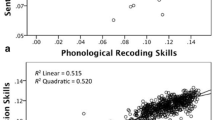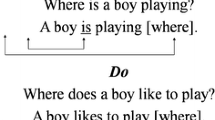Abstract
The present report with two complementary experiments examined the productive knowledge of derivational morphology in 75 grade 4, 5, and 6 “poor” readers further divided into those performing better, or worse, inboth reading and spelling ((R + S +) or R − S −)), or better in the one or the other (mixed) subgroups. Experiment 1 required individual subjects to vocalize rapidly the derived forms of words when primed with 40 target base words in four derivational conditions or levels embedded in sentence frames shown on the computer screen. Experiment 2 required the reverse process of vocalizing the base forms of words when primed with 40, complex derived forms in the same four morphology conditions embedded in sentence frames shown on the computer screen. Results of the analysis of the reaction times show a developmental trend and that the subgroups of poor readers used different mechanisms in producing derived or base forms of words according to the complexity of the orthographic and/or phonological changes needed in the derivational process. The important role of morphemic structure and origin of words in instruction is emphasized.
Similar content being viewed by others
References
Aronoff, M. 1976.Word Formation in Generative Grammar. Linguistic Inquiry Monograph 1, Cambridge, MA: MIT Press.
Bauer, L. 1983.English Word Formation. Cambridge: Cambridge University Press.
Berko, J. 1958. The child’s learning of English morphology.Word 14:150–177.
Caramazza, A. 1988. Some aspects of language processing revealed through the analysis of acquired aphasia: The lexical system.Annual Review of Neurosciences 11:395–421.
Caramazza, A., Laudanna, A., and Romani, C. 1988. Lexical access and inflectional morphology.Cognition 28:297–332.
Carlisle, J. F. 1985.The Relationship Between Knowledge of Derivational Morphology and Spelling Ability in Fourth, Sixth, and Eighth Graders. Haskins Laboratories Status Report on Speech Research SR-82/83 (pp. 151–174). New Haven, CT: Haskins Laboratories.
Carlisle, J. F. 1987. The use of morphological knowledge in spelling derived forms by learning disabled and normal students.Annals of Dyslexia 37:90–108.
Carlisle, J. F., and Liberman, I. Y. 1987.Does the Study of Latin Affect Spelling Proficiency? Haskins Laboratories Status Report on Speech Research SR-92 (pp. 127–136). New Haven, CT: Haskins Laboratories.
Carroll, J. B., Davies, P. and Richman, B. 1971.The American Heritage Word Frequency Book. Boston, MA: Houghton-Mifflin.
Chomsky, N. and Halle, M. 1968.The Sound Pattern of English. New York: Harper and Row.
Cutler, A. 1983. Lexical complexity and sentence processing. In G. B. Flores D’Arcais and R. J. Jarvella (eds.).The Process of Language Understanding (pp. 43–79). New York: John Wiley.
Derwing, B. L. 1976. Morpheme recognition and the learning of rules for derivational morphology.Canadian Journal of Linguistics 21:38–66.
Fowler, C. A., Napps, S. E., and Feldman, L. B. 1985. Relations among regular and irregular, morphologically-related words in the lexicon as revealed by repetition priming.Memory and Cognition 13:241–255.
Freyd, P. and Baron, J. 1982. Individual differences in acquisition of derivational morphology.Journal of Verbal Learning and Verbal Behavior 21:282–295.
Halle, M. 1973. Prolegomena to a theory of word formation.Linguistic Inquiry 4:3–16.
Hanson, V. L. and Wilkenfeld, D. 1985. Morphophonology and lexical organization in deaf readers.Language and Speech 28:269–280.
Henderson, L. 1985. Toward a psychology of morphemes.In A. W. Ellis (ed.).Progress in the Psychology of Language, Volume I (pp. 15–72). London: Erlbaum.
Henry, M. K. 1988. Beyond phonics: Integrated decoding and spelling instruction based on word origin and structure.Annals of Dyslexia 38:258–275.
Jarvella, R. J. and Snodgrass, J. G. 1974. Seeing ring in rang and retain in retention: On recognizing stem morphemes in printed words.Journal of Verbal Learning and Verbal Behavior 13:590–598.
Jastak, S. and Wilkinson, G. S. 1984.Wide Range Achievement Test (rev. ed.). Wilmington, DE: Jastak Associates.
King, E. M. (ed.). 1982.Canadian Tests of Basic Skills: Multilevel edition/Levels 9-12/Forms 5 & 6. Toronto: Nelson.
Leong, C. K. 1987.Children with Specific Reading Disabilities. Lisse. The Netherlands: Swets and Zeitlinger.
Leong, C. K. 1988. A componential approach to understanding reading and its difficulties in preadolescent readers.Annals of Dyslexia 38:95–119.
Mackay, D. G. 1978. Derivational rules and the internal lexicon.Journal of Verbal Learning and Verbal Behavior 17:61–71.
Matthews, P. H. 1974.Morphology. Cambridge: Cambridge University Press.
McClelland, J. and Rumelhart, D. M. 1981. An interactive-activation model of context effects in letter perception, Part I: An account of basic findings.Psychological Review 88:275–407.
Perfetti, C. A. 1985.Reading Ability. New York: Oxford University Press.
Rayner, K. 1978. Eye movements in reading, and information processing.Psychological Bulletin 85:618–660.
Seidenberg, M. S. 1985. The time course of information activation and utilization in visual word recognition.In D. Besner, T. G. Waller, and G. E. Mackinnon (eds.).Reading Research: Advances in theory and practice Vol. 5 (pp. 192–252), New York: Academic Press.
Shoben, E. J. 1982. Semantic and lexical decisions.In C. R. Puff (ed.).Handbook of Research Methods in Human Memory and Cognition (pp. 287–314) New York: Academic Press.
Sterling, C. M. 1982. The psychological productivity of inflectional and derivational morphemes.In D. Rogers and J. A. Sloboda (eds.).The Acquisition of Symbolic Skills (pp. 179–185). New York: Plenum Publishing.
Tyler, A. and Nagy, W. 1987.The Acquisition of English Derivational Morphology. (Tech. Rep. No. 407). Urbana-Champaign, IL: University of Illinois, Center for the Study of Reading.
Williams, E. 1981. On the notions of “lexically related” and “head of a word”.Linguistic Inquiry 12:245–274.
Wysocki, K. and Jenkins, J. (1987). Deriving word meanings through morphological generalization.Reading Research Quarterly 22:66–81.
Author information
Authors and Affiliations
Rights and permissions
About this article
Cite this article
Leong, C.K. Productive knowledge of derivational rules in poor readers. Annals of Dyslexia 39, 94–115 (1989). https://doi.org/10.1007/BF02656903
Issue Date:
DOI: https://doi.org/10.1007/BF02656903




